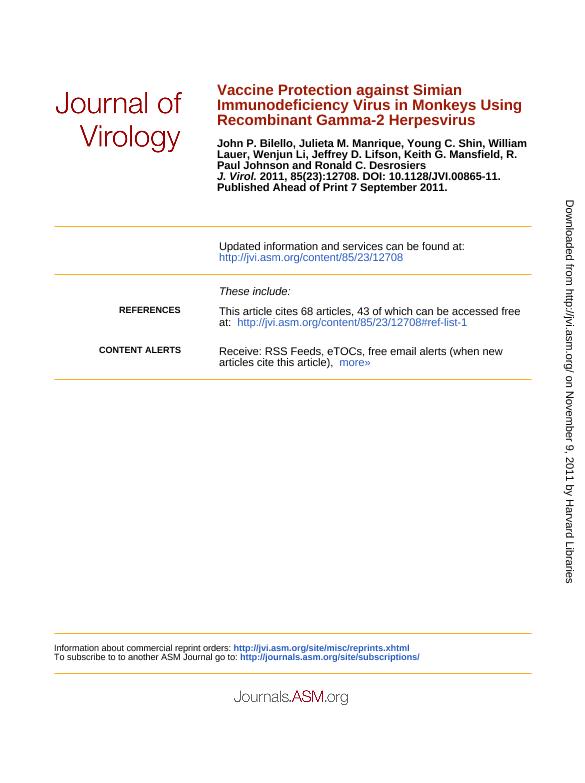Artículo
Vaccine Protection against SIV in Monkeys Using Recombinant gamma-2 Herpesvirus
Bilello, John P.; Manrique, Julieta Marina ; Shin, Young C.; Lauer, William; Li, Wenjun; Lifson, Jeffrey D.; Mansfield, Keith G.; Johnson, R. Paul; Desrosiers, Ronald C.
; Shin, Young C.; Lauer, William; Li, Wenjun; Lifson, Jeffrey D.; Mansfield, Keith G.; Johnson, R. Paul; Desrosiers, Ronald C.
 ; Shin, Young C.; Lauer, William; Li, Wenjun; Lifson, Jeffrey D.; Mansfield, Keith G.; Johnson, R. Paul; Desrosiers, Ronald C.
; Shin, Young C.; Lauer, William; Li, Wenjun; Lifson, Jeffrey D.; Mansfield, Keith G.; Johnson, R. Paul; Desrosiers, Ronald C.
Fecha de publicación:
12/2011
Editorial:
American Society for Microbiology
Revista:
Journal of Virology
ISSN:
0022-538X
Idioma:
Inglés
Tipo de recurso:
Artículo publicado
Clasificación temática:
Resumen
Recombinant strains of replication-competent rhesus monkey rhadinovirus (RRV) were constructed in which strong promoter/enhancer elements were used to drive expression of simian immunodeficiency virus (SIV) Env or Gag or a Rev-Tat-Nef fusion protein. Cultured rhesus monkey fibroblasts infected with each recombinant strain were shown to express the expected protein. Three RRV-negative and two RRV-positive rhesus monkeys were inoculated intravenously with a mixture of these three recombinant RRVs. Expression of SIV Gag was readily detected in lymph node biopsy specimens taken at 3 weeks postimmunization. Impressive anti-SIV cellular immune responses were elicited on the basis of major histocompatibility complex (MHC) tetramer staining and gamma interferon enzyme-linked immunospot (ELISPOT) assays. Responses were much greater in magnitude in the monkeys that were initially RRV negative but were still readily detected in the two monkeys that were naturally infected with RRV at the time of immunization. By 3 weeks postimmunization, responses measured by MHC tetramer staining in the two Mamu-A*01 + RRV-negative monkeys reached 9.3% and 13.1% of all CD8 + T cells in peripheral blood to the Gag CM9 epitope and 2.3% and 7.3% of all CD8 + T cells in peripheral blood to the Tat SL8 epitope. Virus-specific CD8 + T cell responses persisted at high levels up to the time of challenge at 18 weeks postimmunization, and responding cells maintained an effector memory phenotype. Despite the ability of the RRVenv recombinant to express high levels of Env in cultured cells, and despite the appearance of strong anti-RRV antibody responses in immunized monkeys, anti-Env antibody responses were below our ability to detect them. Immunized monkeys, together with three unimmunized controls, were challenged intravenously with 10 monkey infectious doses of SIVmac239. All five immunized monkeys and all three controls became infected with SIV, but peak viral loads were 1.2 to 3.0 log10 units lower and chronic-phase viral loads were 1.0 to 3.0 log10 units lower in immunized animals than the geometric mean of unimmunized controls. These differences were statistically significant. Anti-Env antibody responses following challenge indicated an anamnestic response in the vaccinated monkeys. These findings further demonstrate the potential of recombinant herpesviruses as preventive vaccines for AIDS. We hypothesize that this live, replication-competent, persistent herpesvirus vector could match, or come close to matching, live attenuated strains of SIV in the degree of protection if the difficulty with elicitation of anti-Env antibody responses can be overcome.
Palabras clave:
viral vectors
,
RRV
,
vaccine
,
HIV
Archivos asociados
Licencia
Identificadores
Colecciones
Articulos(SEDE CENTRAL)
Articulos de SEDE CENTRAL
Articulos de SEDE CENTRAL
Citación
Bilello, John P.; Manrique, Julieta Marina; Shin, Young C.; Lauer, William; Li, Wenjun; et al.; Vaccine Protection against SIV in Monkeys Using Recombinant gamma-2 Herpesvirus; American Society for Microbiology; Journal of Virology; 85; 23; 12-2011; 12708-12720
Compartir
Altmétricas



